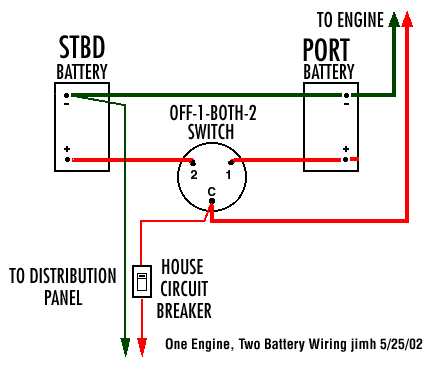ColoradoChris
Member
If I missed a thread that already covers this please point me in the right direction.
Actually the marine switches I have found are usually OFF-1-Both-2 (okay that should help future searchers)
A little background and then the questions. The setup is going into a awd van that I use to haul dogs to various venues. Usually just opening the doors etc while we are there in close proximity is enough but I would eventually like to add some fans. I may even put a fridge in at some point. The vehicle is equipped with a dome override and I have replaced the dome lights with LEDs to limit the draw just in case I forget. It has never been a problem, but I don't want it to be either, so I am thinking of a dual battery setup. (with a possible solar panel and mppt controller later down the road if a fridge happens)
Maybe I am missing something but my thought was that using a marine Off-1-Both-2 I could wire 1 as the starting battery, and 2 as the "house/deep cycle" and leave all the accessories and alternator connected just as they are today.
Then use position 1 for starting and leave it there for a while until the starting battery was fully charged by the alternator. Then switch through off to 2 with the engine running to allow that battery to charge during the trip. Once it is charged I could switch to Both for the remainder of the drive to keep them both topped off. Upon arrival, switch to 2 and run whatever during the day on the deep cycle and start all over for the drive home.
I am guessing that "Both" with one battery significantly more discharged than the other would be a bad idea.
If all of the above is correct, and I then decide to add solar (thinking 24v panel to mppt controller) where would I wire the charge controller to? Should it just go to the deep cycle and I use the "Both" position if I want it to charge the starting battery as well, or would it be better to wire it just like the alternator and let the switch direct the power.
And then finally, if I want to connect an external charger, would off be the right setting and connect to each of the batteries individually?
I borrowed a marine diagram showing what I had in mind. I also assume that some ANL fuses near each battery would be a good idea.

Am I off base? Will it work? What improvements could be made for a manual system?
Actually the marine switches I have found are usually OFF-1-Both-2 (okay that should help future searchers)
A little background and then the questions. The setup is going into a awd van that I use to haul dogs to various venues. Usually just opening the doors etc while we are there in close proximity is enough but I would eventually like to add some fans. I may even put a fridge in at some point. The vehicle is equipped with a dome override and I have replaced the dome lights with LEDs to limit the draw just in case I forget. It has never been a problem, but I don't want it to be either, so I am thinking of a dual battery setup. (with a possible solar panel and mppt controller later down the road if a fridge happens)
Maybe I am missing something but my thought was that using a marine Off-1-Both-2 I could wire 1 as the starting battery, and 2 as the "house/deep cycle" and leave all the accessories and alternator connected just as they are today.
Then use position 1 for starting and leave it there for a while until the starting battery was fully charged by the alternator. Then switch through off to 2 with the engine running to allow that battery to charge during the trip. Once it is charged I could switch to Both for the remainder of the drive to keep them both topped off. Upon arrival, switch to 2 and run whatever during the day on the deep cycle and start all over for the drive home.
I am guessing that "Both" with one battery significantly more discharged than the other would be a bad idea.
If all of the above is correct, and I then decide to add solar (thinking 24v panel to mppt controller) where would I wire the charge controller to? Should it just go to the deep cycle and I use the "Both" position if I want it to charge the starting battery as well, or would it be better to wire it just like the alternator and let the switch direct the power.
And then finally, if I want to connect an external charger, would off be the right setting and connect to each of the batteries individually?
I borrowed a marine diagram showing what I had in mind. I also assume that some ANL fuses near each battery would be a good idea.

Am I off base? Will it work? What improvements could be made for a manual system?
